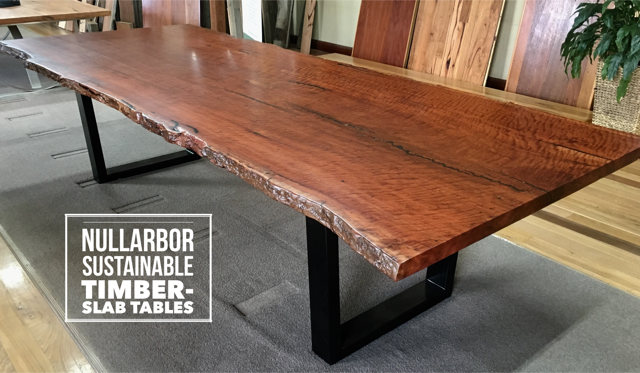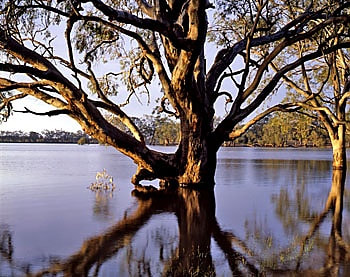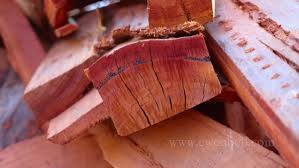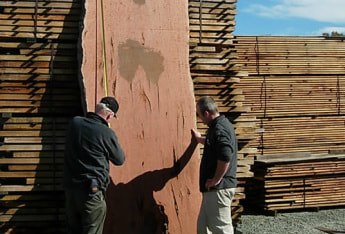|
by Jacqui Donchi Berthaume.
Here at Nullarbor Timber, we thought we'd put the microscope on a local anomaly. We often take advantage of what we have in life or in the environment and that's no exception when it comes to the magnificent River Redgum, a uniquely tinctured timber with a stunning, blood red hue that is native to the very region in which we launched our timber company. Sometimes, despite searching the nation for hidden treasures, the most valuable gifts reside right in your back yard, a shoulder's glance away. Eucalyptus trees are not particularly uncommon. There are over 700 species identified in the eucalyptus camaldulensis genus. What is uncommon however is a native strain of it - and by that we mean not purpose grown in plantations. River Redgum is not only native to Australia in a time when indigenous species of trees are becoming increasingly rare, but also native to its original, ecological land base. In Australia, eucalypts have the broadest natural distribution of the species - usually around river ways and other wetlands. The etymology of the species goes back to a clandestine Camaldoli monastery near Naples, Italy where it earnt its name. A private estate garden near the Camaldoli monastery (L'Hortus Camaldulensis di Napoli), is where the first specimen came to be described in 1832. Material from this tree was used by Frederick Dehnhardt, Chief Gardener at the Botanic Gardens in Naples. Eucalypts are often found along Australian waterways, but none more abundantly than River Redgum which is a vital part of the ecology as it gives stability to river banks. The towering tree can reach great heights and usually grows straight under certain conditions. Twisted branches occur in drier settings, which makes sense when you think of the hot summers around Echuca Moama and the magnificent, exaggerated branches of the Redgum eucalypt. Interestingly, River Redgum is known colloquially as "The Widow Maker". This may have derived from the tree's tendency to drop big boughs - often half the diameter of the trunk itself - with no warning at all. This kind of self-pruning happens in the name of saving water. It also assists the wildlife who routinely take up residence in the holes that form which gives the redgum a very handy basis of fertiliser. River Redgum creates a welcoming habitat for many wildlife fraternities including bats, carpet pythons, rare parrots, and many birds. The dense foliage of the tree also provides shade and shelter from the sun in drier areas. Its a tree that keeps on giving! Due to river redgum's proximity to watercourses, it is exposed to regular flooding in its natural habitat. River red gum prefers soils with clay content. The trees flourish during regular flooding, since it recharges the sub-soil with water. LOCAL KNOWLEDGE - THE FORMATION OF THE BARMAH RED GUM FOREST The formation of the famous Barmah red gum forests is due to a relatively recent geological event in the Murray-Darling Basin involving the Cadell Fault. "River red gum seeds germinate readily after floods and require regular spring floods throughout their life to survive. In the Murray-Darling Basin, such floods are now rare due to river regulation for irrigation, and as a result, 75% of River red gums in the lower Murray are stressed, dead or dying." - WIKIPEDIA The largest remaining stand of river red gum is the (160,000 acres) Barmah-Millewa forest ( Nullarbor Timber Country!!) straddling the border of Victoria and New South Wales near our factory in Echuca Moama, due north of Melbourne, the state's capital city. It retains enormous cultural significance to the Indigenous traditional owners, the Yorta Yorta Nation. Like many stands of river red gum, the Barmah-Millewa has been drastically altered by over 100 years of timber harvesting. There is a paucity of old hollow-bearing trees which provide habitat for rare and threatened fauna such as the superb parrot, brush-tailed phascogale and inland carpet python. At Nullarbor Sustainable Timber, we pride ourselves on re-purposing timbers that are not only local but also have their own brand of exotic provenance. Owning a River Redgum table or creating a bench top or feature wall out of this spectacular timber means you are inviting history into your home or office. The durability of this species of timber - when treated correctly by milling and joining experts - means it will give you decades upon decades of longevity. Its remarkable that a natural material that has been salvaged from a brutally unforgiving environment, mis-appropriated and thrown on the junk pile can be rescued by a company like Nullarbor Timber and brought back to life. You'd think the harsh toil of many years would decay its charm and inherent strength. On the contrary, the older it gets, like a fine wine, the more seasoned it becomes and the longer it will stay with you if handled correctly by professionals. You'II be amazed at the sheer weight, solidarity, durability and aesthetic beauty of a redgum table or building product. Time - for redgum - is not its enemy and we salute what it can teach us. "About 25,000 years ago, displacement occurred along the Cadell fault, a part of the Murray River channel was abandoned, and exists today as an empty channel known as Green Gully. The Goulburn River was dammed by the southern end of the fault to create a natural lake. The Murray River flowed to the north around the Cadell Fault, creating the channel of the Edward River which exists today and through which much of the Murray River's waters still flow. These conditions are highly suitable for river red gum trees, and the growing forests in the area. The formation of the Barmah river red gum forests reigns supreme even today." - WIKIPEDIA Talk to us today: + PHONE (03) 9399 9300 or (03) 54800044 + EMAIL [email protected] Or drop in for a visit: + MELBOURNE SHOWROOM 221 Kororoit Creek Rd Williamstown, Victoria. + AUSTRALIAN STOCK YARD & DISPATCH 92 Graham St Moama, NSW 2731 AUSTRALIA
0 Comments
Leave a Reply. |
Back To BlogAuthorBrendan Donchi, timber supplier and joiner has been working with recycled timber for 24 years. He comes from a long line of timber workers who have been involved with the industry for nearly a century. Archives
February 2020
Categories |
|
© 2014 Nullarbor Sustainable Timber
Privacy Policy |















 RSS Feed
RSS Feed





